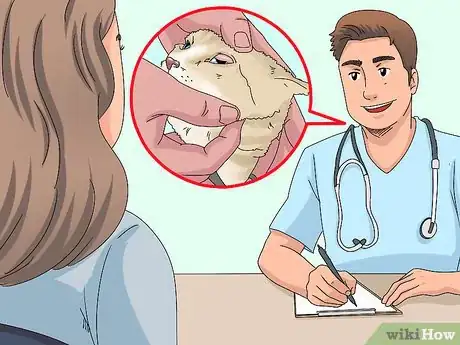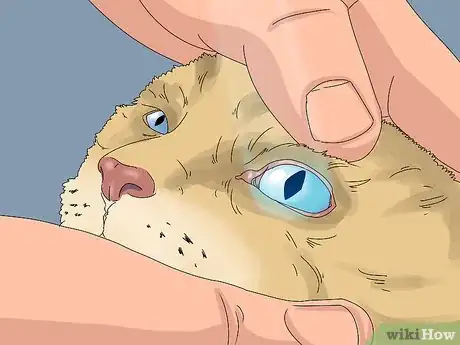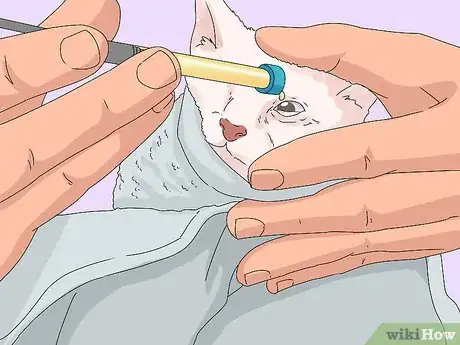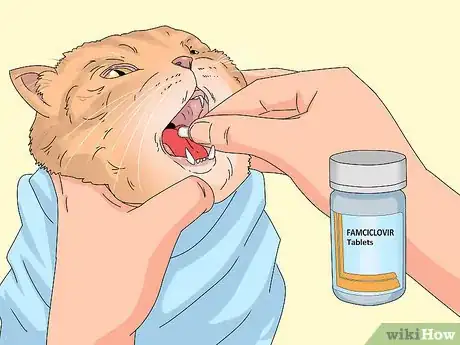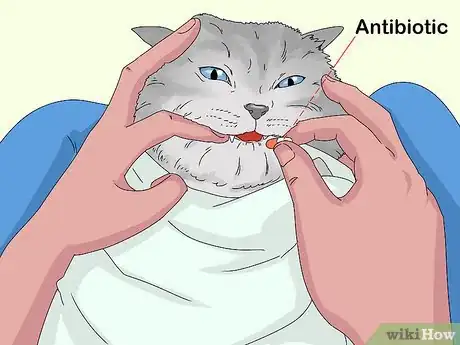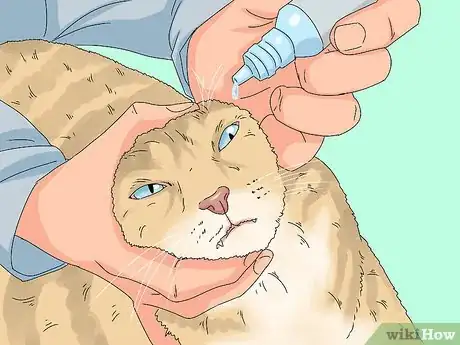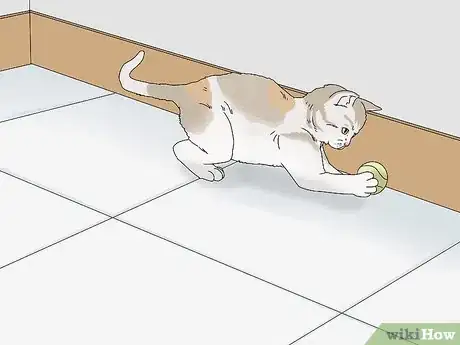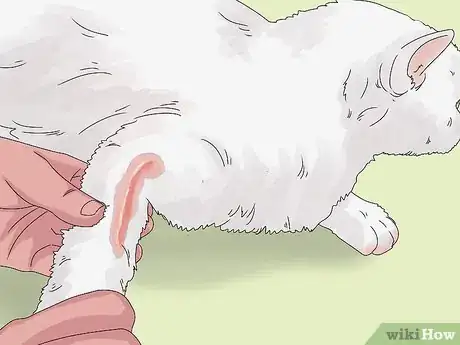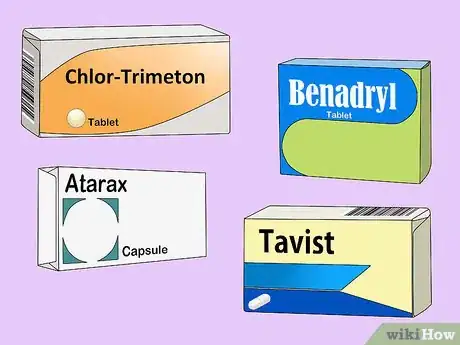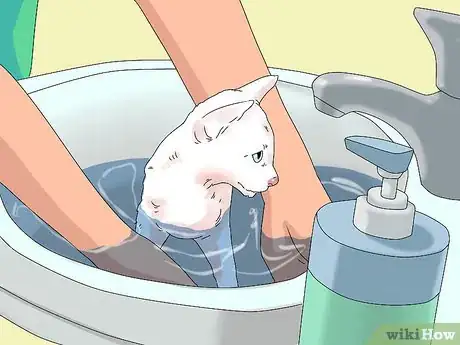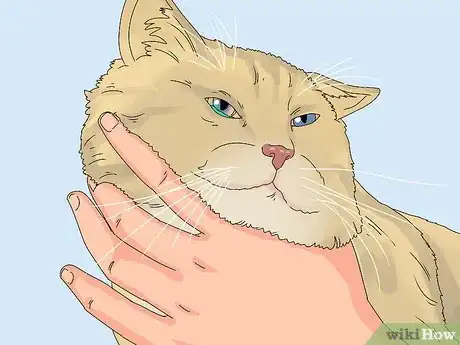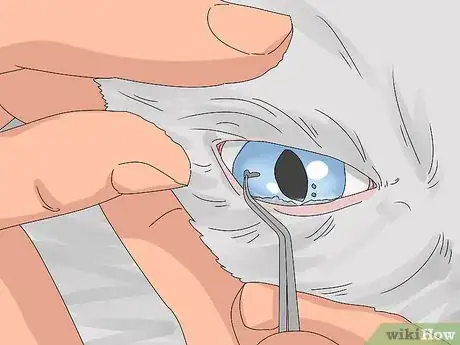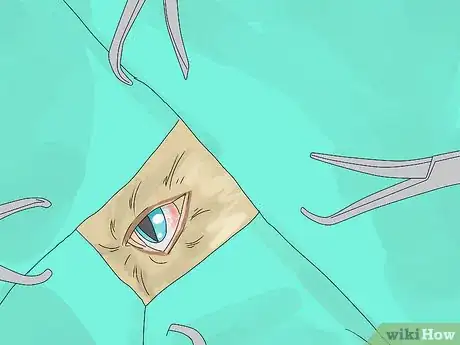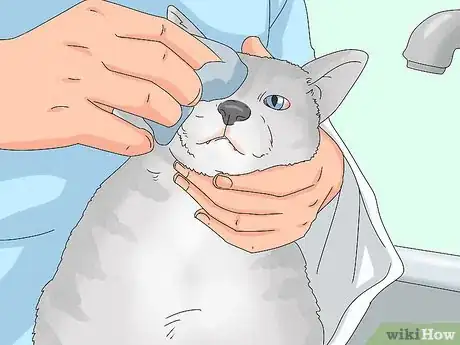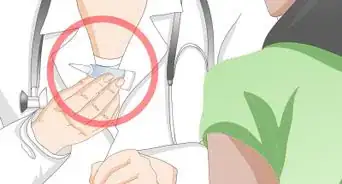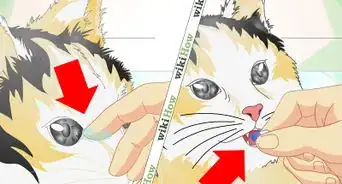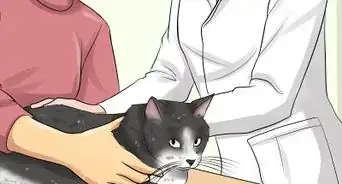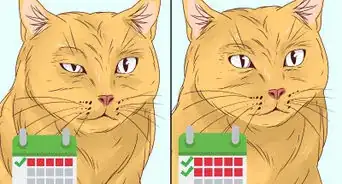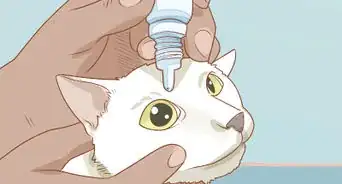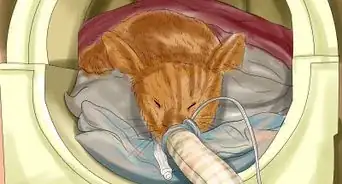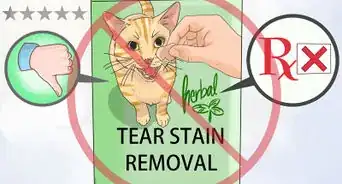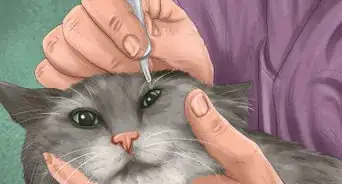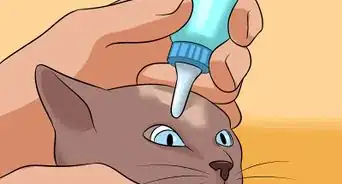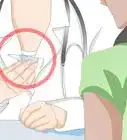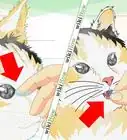This article was co-authored by Deanne Pawlisch, CVT, MA. Deanne Pawlisch is a Certified Veterinary Technician, who does corporate training for veterinary practices and has taught at the NAVTA-approved Veterinary Assistant Program at the Harper College in Illinois and in 2011 was elected to the board of the Veterinary Emergency and Critical Care Foundation. Deanne has been a Board Member of the Veterinary Emergency and Critical Care Foundation in San Antonio, Texas since 2011. She holds a BS in Anthropology from Loyola University and an MA in Anthropology from Northern Illinois University.
There are 10 references cited in this article, which can be found at the bottom of the page.
wikiHow marks an article as reader-approved once it receives enough positive feedback. In this case, 94% of readers who voted found the article helpful, earning it our reader-approved status.
This article has been viewed 86,308 times.
Watery eyes in your cat are generally a symptom of another condition rather than a disease in itself. In other words, if your cat suddenly develops watery eyes, it's likely caused by something like an infection, allergies, or a scratch to the eye. If you notice any problems with your cat’s eye, see a veterinarian immediately to determine a course of treatment.
Steps
Seeing the Veterinarian
-
1Rule out allergies. Allergies can be a common cause of watery eyes in cats. Like humans, cats can be allergic to certain allergens that cause a histamine reaction in the body. In turn, that can cause symptoms like watery eyes.[1]
- The vet can run an allergy test on your cat to determine if that's the cause.
- Cats can be allergic to pollen, trees, and grass, just like humans. They can also be allergic to things like milk, rubber, dust, flea bites, certain foods, and some fabrics (wool, nylon).[2]
-
2Ask about a cold. Before you can alleviate the effects of the virus that’s causing your cat's cold, including the watery eyes, you need an expert opinion. The two main viruses that cause colds are herpes and calici. Three bacteria can cause cold-like symptoms, too: mycoplasma, bordetella, and chlamydia.
- While even a vet may find it difficult to determine what virus or bacteria is causing the problem, they may be able to narrow down the options to determine the best treatment.
Advertisement -
3Discuss conjunctivitis. If your cat has a "cold," they may have developed a more serious eye condition called conjunctivitis. Typically, the treatment for this condition is the same as treatment for the infection, but it's important to take your cat to the veterinarian for a diagnosis if they think your cat has developed conjunctivitis.
-
4Expect a stain test. This test lets the veterinarian see your cat's eyes better. Basically, the vet adds a dye to the cat’s eye which can illuminate problems in the cornea. The vet will then use a blue light to check out the eye more closely.[3]
- A stain test can show an ulcer or erosion on the cornea.
-
5Be ready for other tests. Your veterinarian will likely perform other tests to determine the cause of your cat's watery eyes. For example, they may flush the tear duct system to see if it has good flow. They may also do a pressure test on the eye to rule out glaucoma (which is high pressure in the eye that can damage the optic nerve).[4]
- Cat scans, MRIs, or radiographs may also be needed.
Treating Colds and Conjunctivitis
-
1Look for symptoms of a "cold." Cat colds are much like human colds. That is, you'll see things like a runny nose, runny eyes, and sneezing. Your cat may also be a bit more lethargic than normal. These symptoms in tandem may indicate your cat has a cold. However, a cold in a cat can be caused by a number of viruses or bacteria, so it's important for your cat to see the veterinarian. You shouldn't try to wait it out.
- Your cat can't pass a cold to you, and you can't pass a cold to a cat. However, they can pass cold viruses or bacteria to each other.
- Just like with humans, you won't find a "cure" for a viral cold. Rather, your can give your cat some medications to help alleviate some of the effects of the virus. Other medications may keep the virus from recurring.
- Colds can also lead to conjunctivitis, particularly if the cold is caused by herpes, chlamydia, or mycoplasma. With conjunctivitis, your cat will squint more and have watery eyes, but the discharge from your cat's eyes may be green, yellow, gray, dark, or rusty looking rather than clear. The cornea and iris may turn colors, as well: the cornea may redden, while the iris may look dull. These symptoms may not show up in both eyes.
-
2Try the anti-viral medication Famciclovir. This medication can be prescribed by a veterinarian and is typically used to treat cats with clinical disease due to feline herpesvirus infection. This may be a good option to pursue in more severe cases.
-
3Treat other colds with the antibiotics. Bacterial colds are slightly easier to treat than viral infections. That is, your cat can actually be given medications that will eradicate the bacteria, rather than just treat the symptoms.
- See your veterinarian to get the proper antibiotic medication to treat your cat's particular infection.
- Feline calicivirus is also treated with antibiotics since no particular drug helps with the virus itself. You'll just be giving medications to alleviate the problems it causes. Antibiotics keep the cat from developing other infections. With this virus, your cat will also likely receive pain medications.
-
4Use eye drops. Eye drops are needed when the eye is showing problems because of the virus. Betadine eye drops are a relatively gentle antiviral eye drop, and can be administered at a veterinary office. For more severe infections, your veterinarian will likely prescribe cidofovir.
-
5Alleviate stress. Besides treating the underlying infection, eliminating stress in your cat's life can also help suppress the infection, particularly if it's caused by the herpes virus. The herpes virus can go into remission, but it will still be in your cat's system. It can be brought to the surface again if the cat is under stress.
- Try isolating your cat in its own room, diffusing pheromone sprays in the area where they spend most of their time, and/or bringing more toys into their environment to help reduce stress.[5]
- The main stresses in a cat's life are things like a new pet in your home, you being gone for extended periods (on vacation), the cat being boarded, and changes in the routine or environment (such as moving or remodeling). While you can't eliminate all of your cat's stressors, you can try to keep them to a minimum.
Dealing with Allergies
-
1Watch for allergy symptoms. While watery eyes are sometimes a symptom of allergies, cat allergies often show up on the skin. Therefore, you may notice crusty skin, lesions, or hair loss. Your cat may also scratch excessively.[6]
-
2Use antihistamines for allergies. Cat allergies are treated much like human allergies. That is, most of the time, your cat will be prescribed an antihistamine to help deal with the body's reaction to an allergen.[7] The main antihistamines used for cats are Chlor-Trimeton, Benadryl, Atarax, and Tavist.[8]
- Steroids may also be helpful when your cat has a particularly bad allergy attack, but they should only be used for a short period. Ask your vet if it's a good option for your cat.
-
3Minimize allergens. If you have a board certified veterinary dermatologist do an allergy test, they will be able to tell you what things your cat is allergic to so that you can limit exposure. For instance, if your cat is allergic to pollen, grass, trees, or some bugs, you can keep the cat inside and keep the windows closed as much as possible. You can make sure dust is minimized around the house and switch foods to find one your cat isn't allergic to.[9]
-
4Try an omega-3 fatty acid supplement. Some cat owners have had good luck with omega-3 fatty acids improving their cat's allergies. When looking for a supplement, make sure it's derived from fish oil. Also, ask your veterinarian about an appropriate dose for your cat.[10]
-
5Bathe your cat. This recommendation may sound like one you want to avoid. However, most of the time, cats aren't as resistant to bathing as you might think. Use a feline shampoo that’s recommended by a veterinary physician, and use it as frequently as they recommend to use it. You can also give your cat a bath using a colloidal oatmeal, hypoallergenic, or hydrocortisone shampoo (made for cats) to help alleviate some of the itchiness your cat is experiencing.[11]
- Try bathing your cat when you notice they are itching more or they have a flare up.
Treating Scratches, Foreign Objects, and Chronic Watery Eyes
-
1Check for signs of an object in the eye. Sometimes, your cat will get something in its eye that will cause irritation. It could be a splinter, for instance. It could also be something like sand, glass, metal, or really any small object that attaches to the cat's eye.[12]
- You'll see watering, of course, as well as redness and swelling. The cat may try to scratch at its eye, and the eye might twitch a bit.
- It’s best to see a board certified veterinary ophthalmologist if there’s something wrong with your cat's eye.
-
2Watch for signs of a scratch. Cats are sometimes able to get scratches or ulcers in their eyes. They can accidentally catch their eyes with one of their own claws, or an eye could be scratched by another cat (either in play or in a fight). They can also catch their eye on other objects. Even not enough tears can cause a cat to get an ulcer in its eye, as the eyelid rubs against the eye without lubrication.[13]
-
3Treat scratches and objects. The veterinarian will obviously need to remove any object in your cat's eye. A simple flush may do it, but they may also need to use tweezers. In some cases, the eye may need to be sewn up. The vet will also likely prescribe antibiotics, either in eye drop form or a pill.[14]
- In some cases, the eyelid may need to be sewn closed for a period to heal.
-
4Decide if surgery is an option. Sometimes, the eyelids or hairs around the eyes are what cause the eye to tear up. In those cases, it may be appropriate for the cat to undergo surgery performed by a board certified veterinary ophthalmologist in order to correct the issue, though it cannot always be corrected.[15]
-
5Care for chronic watery eyes. Sometimes, a cat will just have watery eyes that cannot be changed. If your cat is this way, you should wash around the cat's eyes each day with a warm, wet cloth. Make sure to dry off the area, as well.[16]
References
- ↑ https://www.vetary.com/cat/condition/watery-eyes
- ↑ http://www.peteducation.com/article.cfm?c=1+2141&aid=502
- ↑ https://www.vetary.com/cat/condition/watery-eyes
- ↑ https://www.vetary.com/cat/condition/watery-eyes
- ↑ http://www.pethealthnetwork.com/cat-health/cat-behavior/how-can-you-reduce-your-cats-stress-home
- ↑ http://www.peteducation.com/article.cfm?c=1+2141&aid=502
- ↑ https://www.vetary.com/cat/condition/watery-eyes
- ↑ http://www.peteducation.com/article.cfm?c=1+2141&aid=502
- ↑ http://www.peteducation.com/article.cfm?c=1+2141&aid=502
- ↑ http://www.peteducation.com/article.cfm?c=1+2141&aid=502
- ↑ http://www.peteducation.com/article.cfm?c=1+2141&aid=502
- ↑ http://www.merckvetmanual.com/special-pet-topics/emergencies/eye-emergencies
- ↑ http://www.merckvetmanual.com/special-pet-topics/emergencies/eye-emergencies
- ↑ http://www.merckvetmanual.com/special-pet-topics/emergencies/eye-emergencies
- ↑ http://www.petplace.com/article/cats/diseases-conditions-of-cats/symptoms/epiphora-excessive-tearing-in-cats
- ↑ http://www.petplace.com/article/cats/diseases-conditions-of-cats/symptoms/epiphora-excessive-tearing-in-cats
About This Article
Before you treat your cat's watery eyes, take it to the vet so they can determine what's causing them, like allergies, a cold, or conjunctivitis. After the vet diagnoses your cat, follow whatever treatment plan they prescribe. If your cat has a cold or conjunctivitis, you'll likely need to give it antibiotics or anti-viral medication, as well as administer eye drops prescribed by your vet. For allergies, your vet may prescribe you an antihistamine. For more tips from our Veterinary co-author, like how to treat chronic watery eyes, scroll down!


